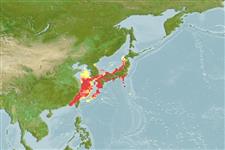Élasmobranches (requins et raies) (sharks and rays) >
Heterodontiformes (Bullhead and horn sharks) >
Heterodontidae (Bullhead, horn, or Port Jackson sharks)
Etymology: Heterodontus: heteros (Gr.), different; odontos (Gr.), tooth, referring to pointy teeth (for clutching prey) at front of jaws, different than rounded molar-like teeth (for grinding hard-shelled invertebrates) at the back (See ETYFish); japonicus: -icus, (Gr.) belonging to: Japan, described from a collection of fishes from the seas of Japan (See ETYFish).
More on authors: Miklouho-Maclay & Macleay.
Environment: milieu / climate zone / depth range / distribution range
Écologie
marin démersal; profondeur 6 - 100 m (Ref. 106604). Subtropical; 43°N - 23°N, 118°E - 143°E
Northwest Pacific: off Japan, Korean Republic, northern China including Taiwan Island.
Taille / Poids / Âge
Maturity: Lm ? range ? - ? cm
Max length : 120 cm TL mâle / non sexé; (Ref. 247)
Found near shore on the continental shelf, more commonly on rocky and kelp-covered bottom (Ref. 43278, 11230). Feeds on crustaceans, mollusks (including top shells), small fishes and sea urchins. Oviparous (Ref. 43278, 50449). Grabs prey by protruding its jaw with considerable distance.
Life cycle and mating behavior
Maturité | Reproduction | Frai | Œufs | Fécondité | Larves
Oviparous. Eggs are laid in rocks or in kelp at depths of about 8 or 9 m and are present from March through September. Eggs are more abundant, however, in March and April. Eggs are hatched in about a year; size at hatching is about 18 cm. There may be a `nest' for several females laying eggs but this is not a true nest. A female lays two eggs at a time, for 6 to 12 spawnings.
Compagno, L.J.V., 1984. FAO Species Catalogue. Vol. 4. Sharks of the world. An annotated and illustrated catalogue of shark species known to date. Part 1 - Hexanchiformes to Lamniformes. FAO Fish. Synop. 125(4/1):1-249. Rome, FAO. (Ref. 247)
Statut dans la liste rouge de l'IUCN (Ref. 130435: Version 2024-2)
Menace pour l'homme
Traumatogenic
Utilisations par l'homme
Pêcheries: intérêt commercial mineur
Outils
Articles particuliers
Télécharger en XML
Sources Internet
Estimates based on models
Preferred temperature (Ref.
123201): 16.6 - 23.5, mean 20.5 °C (based on 50 cells).
Phylogenetic diversity index (Ref.
82804): PD
50 = 0.5059 [Uniqueness, from 0.5 = low to 2.0 = high].
Bayesian length-weight: a=0.00380 (0.00165 - 0.00876), b=3.15 (2.95 - 3.35), in cm total length, based on LWR estimates for this (Sub)family-body shape (Ref.
93245).
Niveau trophique (Ref.
69278): 3.6 ±0.53 se; based on food items.
Résilience (Ref.
120179): Faible, temps minimum de doublement de population : 4,5 à 14 années (Fec=12).
Fishing Vulnerability (Ref.
59153): High to very high vulnerability (72 of 100).
